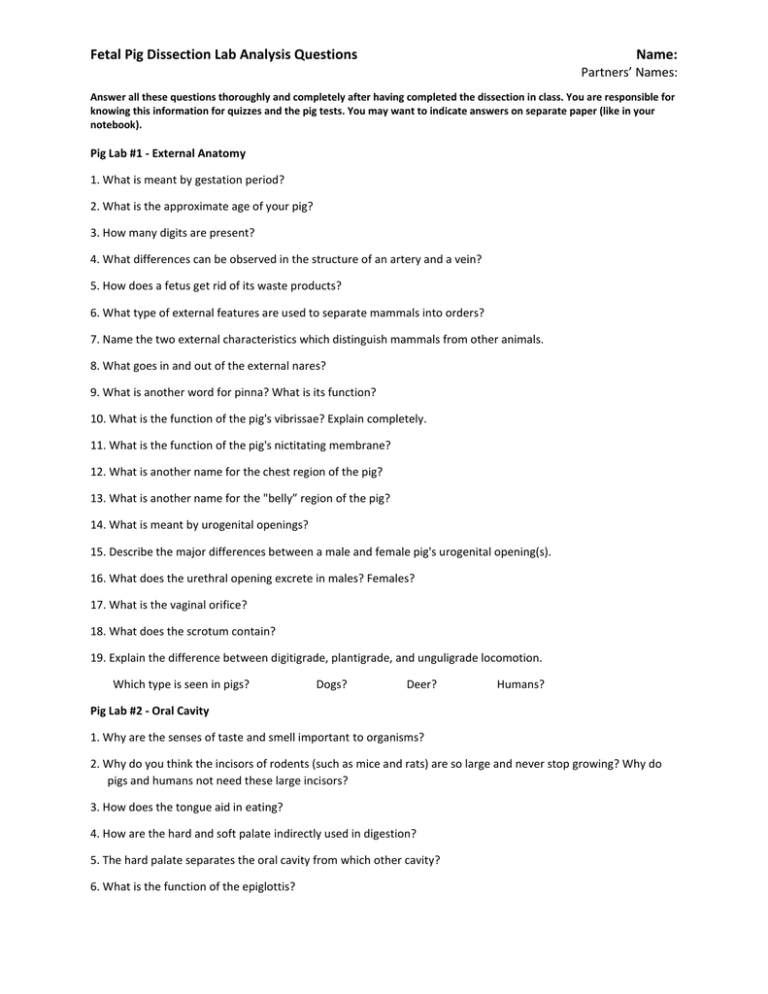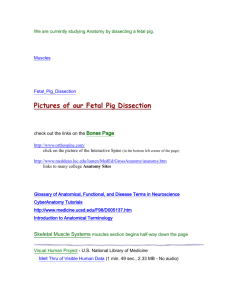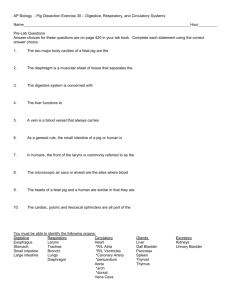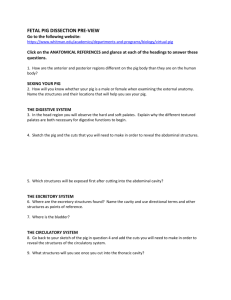Pig Lab Questions
advertisement

Fetal Pig Dissection Lab Analysis Questions Name: Partners’ Names: Answer all these questions thoroughly and completely after having completed the dissection in class. You are responsible for knowing this information for quizzes and the pig tests. You may want to indicate answers on separate paper (like in your notebook). Pig Lab #1 - External Anatomy 1. What is meant by gestation period? 2. What is the approximate age of your pig? 3. How many digits are present? 4. What differences can be observed in the structure of an artery and a vein? 5. How does a fetus get rid of its waste products? 6. What type of external features are used to separate mammals into orders? 7. Name the two external characteristics which distinguish mammals from other animals. 8. What goes in and out of the external nares? 9. What is another word for pinna? What is its function? 10. What is the function of the pig's vibrissae? Explain completely. 11. What is the function of the pig's nictitating membrane? 12. What is another name for the chest region of the pig? 13. What is another name for the "belly” region of the pig? 14. What is meant by urogenital openings? 15. Describe the major differences between a male and female pig's urogenital opening(s). 16. What does the urethral opening excrete in males? Females? 17. What is the vaginal orifice? 18. What does the scrotum contain? 19. Explain the difference between digitigrade, plantigrade, and unguligrade locomotion. Which type is seen in pigs? Dogs? Deer? Humans? Pig Lab #2 - Oral Cavity 1. Why are the senses of taste and smell important to organisms? 2. Why do you think the incisors of rodents (such as mice and rats) are so large and never stop growing? Why do pigs and humans not need these large incisors? 3. How does the tongue aid in eating? 4. How are the hard and soft palate indirectly used in digestion? 5. The hard palate separates the oral cavity from which other cavity? 6. What is the function of the epiglottis? Fetal Pig Dissection Lab Analysis Questions Name: Partners’ Names: 7. What substances are secreted by the oral cavity of humans that aid in digestion? Name these substances and tell what each does to help digestion. 8. The esophageal opening is the top of which tube? Where does this tube lead? Pig Lab #3 - Digestive System 1. To what organ does the umbilical vein lead? 2. Describe the intestinal mesentery. 3. Where is the intestinal mesentery attached? 4. In humans, what structure is found at the junction of the small and large intestine? 5. What is the posterior opening of the digestive tract called? The anterior opening? 6. How many lobes (sections) does the liver have? 7. Where does the bile duct lead to and what substance does it carry? 8. List the function of each organ below: a . stomach b. esophagus c. small intestine d. large intestine e. pancreas f. liver g. gall bladder 9. What structure separates the thoracic cavity from the abdominal cavity? Spasms of this muscle cause what problem? 10. List two organs found in the thoracic cavity. 11. Describe the appearance of the inside of the stomach. How do the rugae within the stomach aid in mechanical digestion? 12. How can you tell where the small intestine stops and the large intestine begins? 13. How do enzymes produced in the pancreas come in contact with food since food does not pass through the pancreas? 14. What is an ulcer? 15. What is done in an appendectomy? Through which cavity does the surgeon enter? Pig Lab #4 - Circulatory System 1. What's the function of the thymus? 2. Which is larger, the right or left ventricle? Why? Fetal Pig Dissection Lab Analysis Questions Name: Partners’ Names: 3. Describe the difference between the right and left atria. 4. From what chamber does the pulmonary artery exit? 5. From what chamber does the aorta originate? 6. To what structure do the pulmonary arteries lead? 7. What is the importance of the coronary circulation? 8. What problem results if coronary circulation is interrupted? 9. Why are arteries larger than veins? 10. What are the primary functions of the circulatory system? 11. Name the process that moves molecules from an area of high concentration to an area of low concentration. In which type of blood vessel does this process occur? Why? 12. What is the function of heart valves? 13. In humans, what results when a valve is leaking blood backwards in the heart? 14. Why is it so difficult to get to the heart during open heart surgery? 15. Identify the body part(s) supplied by the artery or vein listed below: a . hepatic artery b. carotid artery c. thoracic aorta d. aorta e. cranial vena cava f. caudal vena cava Pig Lab #5 - Respiratory System 1. Describe the exchange of gases in the lungs. 2. Explain (in paragraph form) the pathway of air from outside the body to the bloodstream. Be sure to use the following words: nose, mouth, nasal cavity, lung, bronchi, trachea, alveoli, and bronchioles. 3. Why is the trachea constructed with rings of cartilage? 4. What's the primary function of the respiratory system? 5. Why do you think the bronchi branch extensively into tiny air tubes? 6. Carbon dioxide is exhaled from the lungs. How is it produced? Pig Lab #6 - Urogenital System 1. What is the function of the kidneys? How many does the pig have? Where are they located? 2. What substances are carried in the urethra? Fetal Pig Dissection Lab Analysis Questions Name: Partners’ Names: 3. In which of the female's reproductive structures would embryonic or fetal pigs be found? 4. List a function for each of the following and write whether each is a male or female structure. a . ovary b. testis c. uterine horn d. vagina e. epididymis f. urethra 5. Why is the scrotum important? 6. Which blood vessel - renal artery or renal vein - would have the cleanest blood? Why? 7. Kidneys are important organs. What helps to protect kidneys within the pig's body? 8. List a function for: a . ureter b. urinary bladder c. urethra Pig Lab #7 - Nervous System 1. What is the function of the cranium? 2. Which lobes of the brain receive input from the nose? 3. What portion of the brain controls voluntary muscle movements? 4. What divides the cerebrum into a right and left hemisphere? 5. What is the role of the cerebellum in the body? 6. What part of the brain is the most posterior? 7. List a function for each of the following: a . cerebrum b. cerebellum c. olfactory lobe d. medulla oblongata 8. When a person suffers from a stroke, what happens? Congratulations! At this point you have completed the laboratory. Review for the Lab Practical which asks you to know terminology, structures, and functions. Keep all of the parts of your pig together and have your teacher check the quality of your group's dissection.






